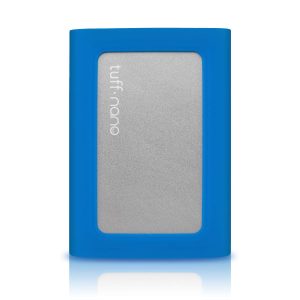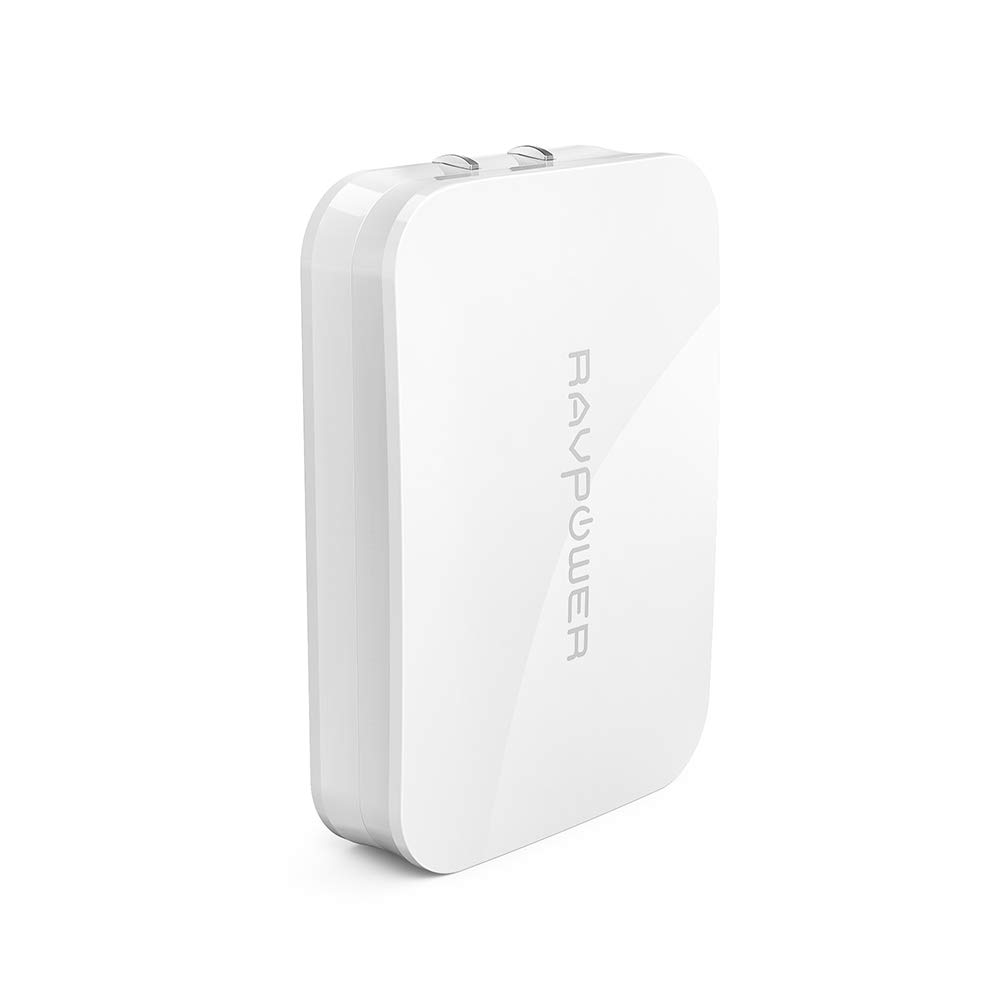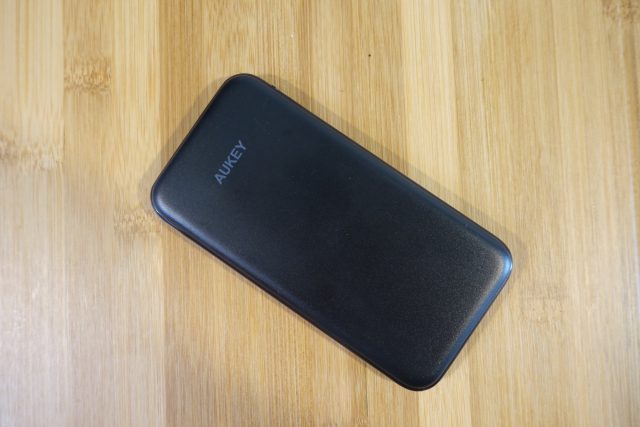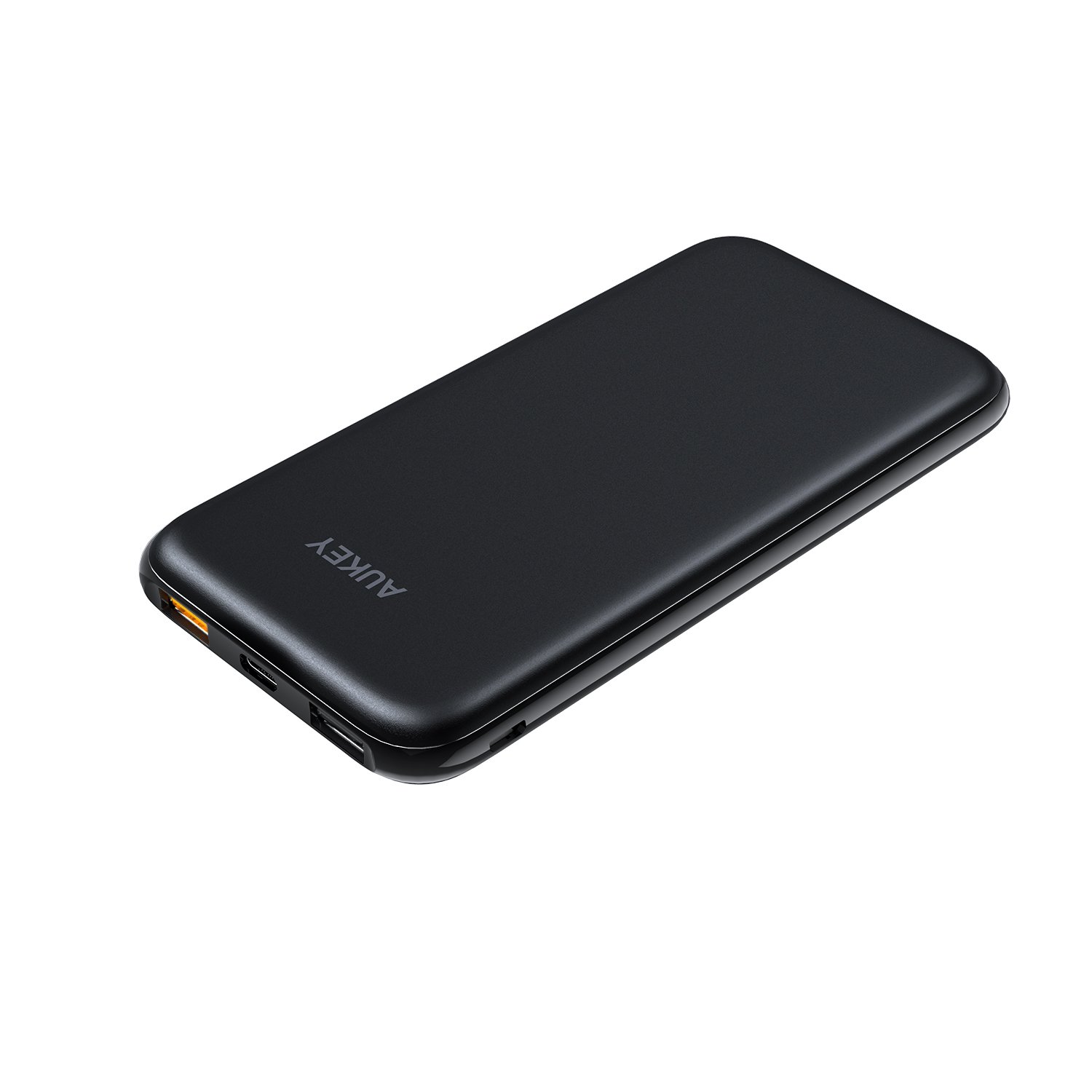Best USB-C external SSD
CalDigit Tuff Nano
-
The CalDigit Tuff Nano portable SSD.Valentina Palladino
-
It measures 2.99×2.14×0.57 inches and comes with a colored case.Valentina Palladino
-
Its USB-C port has a waterproof rating of its own.Valentina Palladino
-
The Tuff Nano next to an iPhone XR.Valentina Palladino
| Specs at a glance: CalDigit Tuff Nano | |
|---|---|
| Price | $149 |
| Capacities | 512GB |
| USB interface | USB 3.1 Gen 2 |
| Max speed (read/write in MB/s) | 1088/900 |
| Dimensions/weight | 2.99×2.14×0.57 in/ 2.6 ounces |
| Compatibility | macOS and Windows |
| Extras | IP67 rated, iPad Pro compatible (with iPadOS), included USB-C to A cable, included silicone case |
While our previous pick, the Samsung T5, remains a good option, CalDigit’s $149 Tuff Nano external SSD pushed it out of the top spot. It takes much of what we like about the T5 and adds to it an IP67-rated design, iPad Pro compatibility, an included bumper case, and blazing fast read and write speeds.
The CalDigit Tuff Nano was one of the fastest portable SSDs we tested for our portable SSD guide. Its scores were up there with the luxury drives—devices that cost $400 or more when you need them to contain more than 1TB of storage. While The Tuff Nano only comes in a 512GB model right now, it’s well priced at $149.
The Tuff Nano’s tiny frame is protected against water and dust, but its USB-C port has its own IPX8 rating, which makes it waterproof. Each drive also comes with a silicone bumper that you can slide over the drive, giving it a bit more drop protection (and a personal flare with the color of your choosing).
Like most other portable SSDs we’ve tested, the CalDigit Tuff Nano includes a USB-C to C cable and a USB-C to A cable in its box, so you can use it with many kinds of PCs. It’s pre-formatted for macOS out of the box, but it comes with instructions to format the drive for Windows machines.
We know that $149 for a 512GB portable drive isn’t the best price, but we think the Tuff Nano’s superior performance and overall slick and durable design makes it worth the extra money.
However, if you’re looking to spend a little less, you can opt for the Samsung T5 (a 500GB model costs just $93) or the SanDisk Extreme portable SSD (500GB for $89). Both of these alternative options perform similarly—speedy, but not as fast as the Tuff Nano. The Samsung T5 offers AES 256-bit hardware encryption and optional password protection, while the SanDisk Extreme has an IP55-rated design that’s also shock-, vibration-, water-, and dust-resistant.
The Good
- A faster than average portable SSD with a compact design and a good price.
The Bad
- Gets hot after long-term use.

CalDigit Tuff Nano
Best USB-C cable
Anker Powerline+
-
Anker Powerline+ cables made of braided nylon.Valentina Palladino
-
Anker has numerous kinds of Powerline+ cables, including USB-C to Lightning.Valentina Palladino
-
They come in various lengths as well.Valentina Palladino
It's not necessary to buy an OEM's special charging cables for your smartphone, tablet, or other devices now that Anker has the Powerline+ line of USB-C cables. Out of all the USB-C cables we tested, Anker Powerline+ cables provide the best value for money when it comes to USB-C to A and USB-C to Lightning connectors.
First and foremost, we appreciate that most Powerline+ cables are braided nylon accessories. Not every Powerline+ cable is made with braided nylon, but the ones we tested were—you won't have to worry about these wires breaking or fraying, no matter how roughly you (or your kids) treat them. Depending on the connectivity you need, you can also find Powerline+ cables in many lengths including 3-feet, 6-feet, and 10-feet. We also appreciate that most Powerline+ cables, both single- and multi-packs, come in at less than $25.
We were also impressed by the charging speeds we observed in the Powerline+ cables tested. The USB-C to Lightning cable charged an iPhone XS from zero to 80 percent in one hour and from zero to fully charged in a little more than two hours (using a MacBook 61W USB-C charger). Using the Anker Dual USB PowerPort II 24W Charger, the Powerline USB-C to USB-A 2.0 cable charged a Pixel 3 smartphone from zero to 55 percent in one hour and from zero to fully charged in two hours.
Admittedly, USB-C cables are only one part of the charging puzzle. The PD charger (that plugs into an outlet) will have an effect on charging time and maximum power delivery, as will your device's own capabilities. Nevertheless, it's important to have a durable USB-C cable with which to charge your most necessary electronics, and Anker's Powerline+ cables are the best ones for that.
The Good
- Reliable braided nylon cables that come in many connector options (USB-C to A, Lightening, etc).
The Bad
- Cables that support faster transfer speeds can be more expensive.

Anker Powerline+ USB-C to A Cables
Best USB-C PD Charger
RavPower 45W PD Charger
-
RavPower's 45W PD Charger can power up mobile devices quickly.Valentina Palladino
-
It's also super slim and easy to travel with.Valentina Palladino
| Specs at a glance: RavPower 45W PD Charger | |
|---|---|
| Price | $49.99 |
| Compatibility | Anything with USB-C charging |
| Power delivery | 45W (PD 3.0) |
| Dimensions | 2.83 x 2.12 x 0.56 inches |
| Other perks | GaN technology, protections against overcharging and overheating |
Those who need a power-delivery charger that's small, fast, and fairly affordable need look no further than RavPower's 45W USB-C PD Charger. The tiny rectangle beat out the rest of the PD chargers we tested thanks to its compact design. Measuring just .56 inches thick, this charger takes up a negligible amount of space in a bag or backpack but it packs a powerful punch in terms of charging.
With its one USB-C port, the charger can power any USB-C device like a smartphone or a laptop. A USB-C cable isn't included so you need to provide one, but that's the case with most PD chargers. RavPower's device charged a Pixel 3 smartphone to 80 percent from zero in just one hour, and it only took about 100 minutes, or a little over an hour and a half, to charge the smartphone to 100 percent. That means you won't have to wait long in an airport or a coffee shop to get a safe amount of juice in your previously dead smartphone.
RavPower's PD charger has two limitations: it only has one USB-C port, and it's rectangular design can block other outlets depending on where you plug it in. The latter problem is one that most PD chargers have since they tend to be blocky. RavPower's charger is, by far, the most slim PD charger we tested, but that 45 watts of power has to go somewhere so the device's shape is understandable.
But not every PD charger only has one USB-C port, or one port in general. Those who want a charger with more flexibility should consider Aukey's 30W USB-C PD Charger because it has one USB-C port and one USB-A port, allowing you to connect two devices at once. It also has a "dynamic detect" feature that lets it direct all 30 watts of power delivery to one port when only one device is connected. When charging two devices at once, power delivery drops to 18 watts.
Aukey's charger may have more ports, but it's not as quick to charge as RavPower's. It charged a Pixel 3 smartphone to 70 percent in one hour, and took about two hours to charge the smartphone fully to 100 percent. We recommend the $49 RavPower 45W charger for those who want speedy charging in a compact package, while those who can sacrifice speed and slimness to save some money should go for the $26 Aukey charger.
The Good
- Ultra-compact charger that quickly powers all types of USB-C devices.
The Bad
- Only has one USB-C port.

RavPower 45W USB-C PD Charger
Best USB-C power bank
Aukey PB-Y13 10,000mAh 18W Power Bank

| Specs at a glance: Aukey PB-Y13 Power Bank | |
|---|---|
| Price | $29.99 |
| Ports | 1 x USB-C, 2 x USB-A |
| Capacity | 10,000mAh |
| Power output (wattage) | 18W |
| Other perks | PD 2.0 via USB-C, Quick Charge 3.0 via USB-A |
Smartphone OEMs may have started updating their handsets to charge via USB-C, but most haven't figured out how to strike the right balance of thinness and battery capacity in their smartphones. If your USB-C smartphone tends to die before the day is out, Aukey's 10,000 mAh (or 37Wh) PB-Y13 power bank can bring it back to life. The slim charger is about the size of a typical smartphone and its 18W USB-C port has PD 2.0 technology, which isn't the latest variant but is still capable enough to power up a smartphone or other mobile device like a tablet or a Nintendo Switch.
In addition to one USB-C port, the device has two USB-A ports, one of which supports Quick Charge 3.0. If you have a cable with USB-C on one end and USB-A on the other, you can fast-charge Quick Charge-compatible devices with this power bank. The device itself also charges up fairly quickly—it takes only four hours for the power bank to regain all the juice it can. Quick Charge 3.0 only applies to the USB-A port, but the USB-C PD port also does well to charge mobile devices quickly. The power bank can charge an iPhone XS from zero to roughly 85 percent in an hour. The kicker is that it's $29, so it's nice and affordable for the performance it supplies.
If you want a battery that works well for laptops or other larger devices, on the other hand, we also like the ZMI PowerPack 20000 (aka the ZMI QB820). With a 20,000 mAh (or 72Wh) capacity and 40W USB-C PD port (45W output in total), it's much more powerful than a more phone-focused power bank like the PB-Y13 and is strong enough to charge MacBook Pros, many Windows ultrabooks, and so on. Bigger laptops will still refill faster with their dedicated chargers, but there's enough juice here to be effective on the go.
Its aluminum body is thicker than that of Aukey's device, but otherwise its design is similarly shaped, with one USB-C port and two USB-A 2.0 ports, one of which supports Quick Charge 3.0. Interestingly, it can also double as a hub, meaning it can effectively add those USB-A ports to a connector-scarce laptop. Since there's no difference in charging speed between this and an 18W battery like the PB-Y13 when it comes to a smartphone, ZMI's power bank is only really worth it for people who plan to use the battery with a laptop or similarly large device. That said, at $69, it's still nice value relative to other battery packs with similar output.
The Good
- Slim design and charges smartphones at the fastest possible rate.
The Bad
- Doesn’t come with USB-C to C cable.

reader comments
161